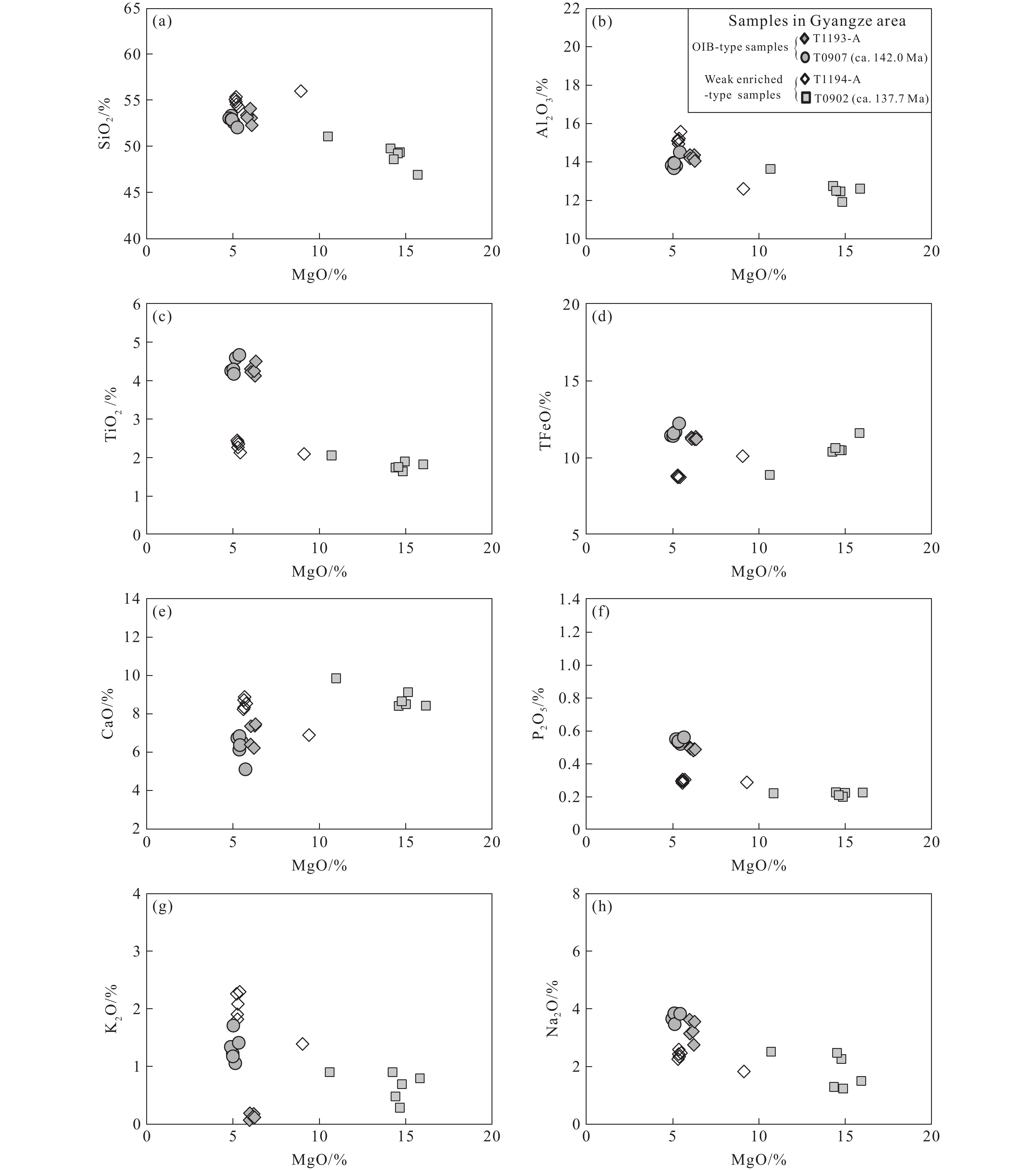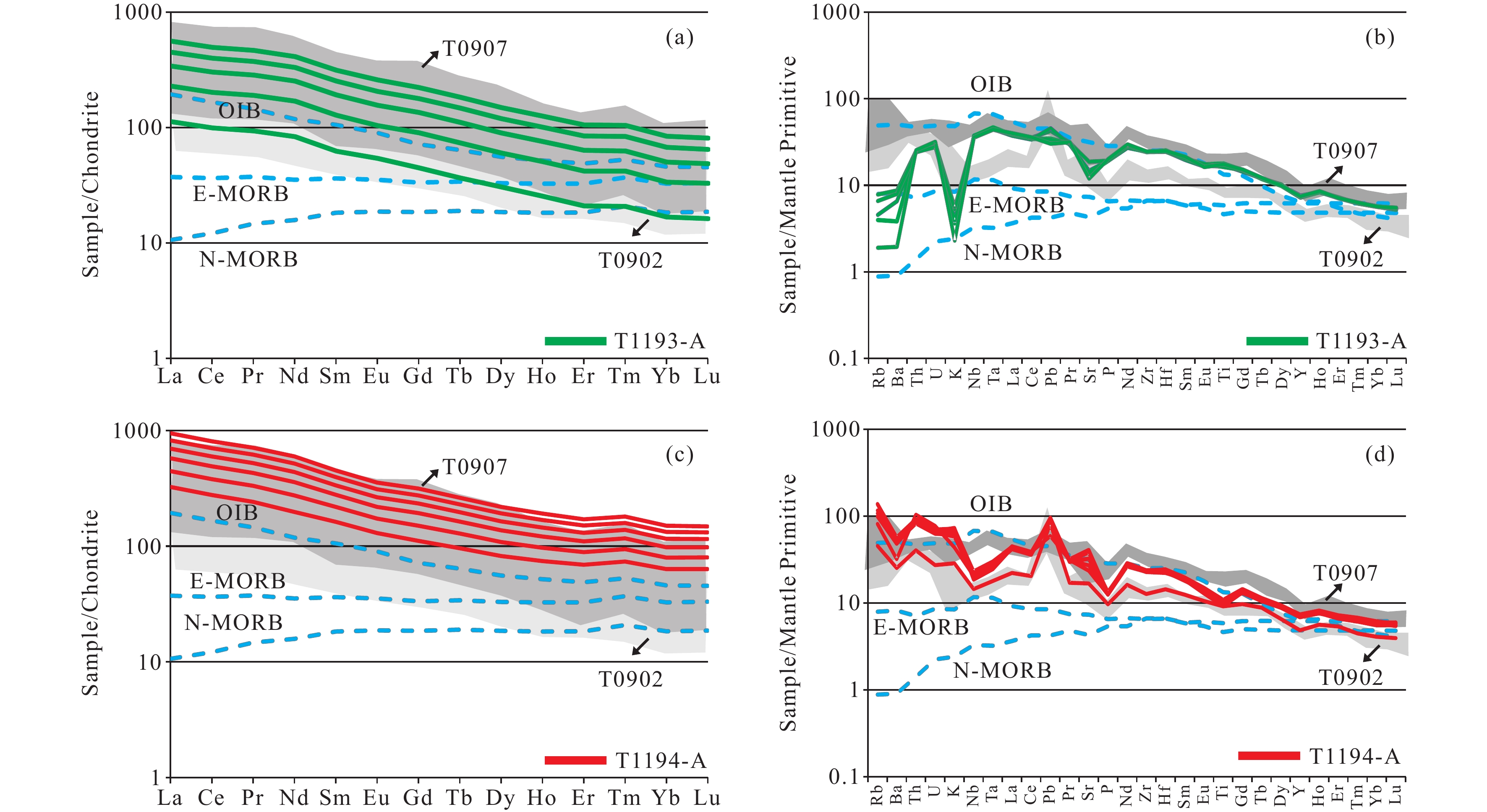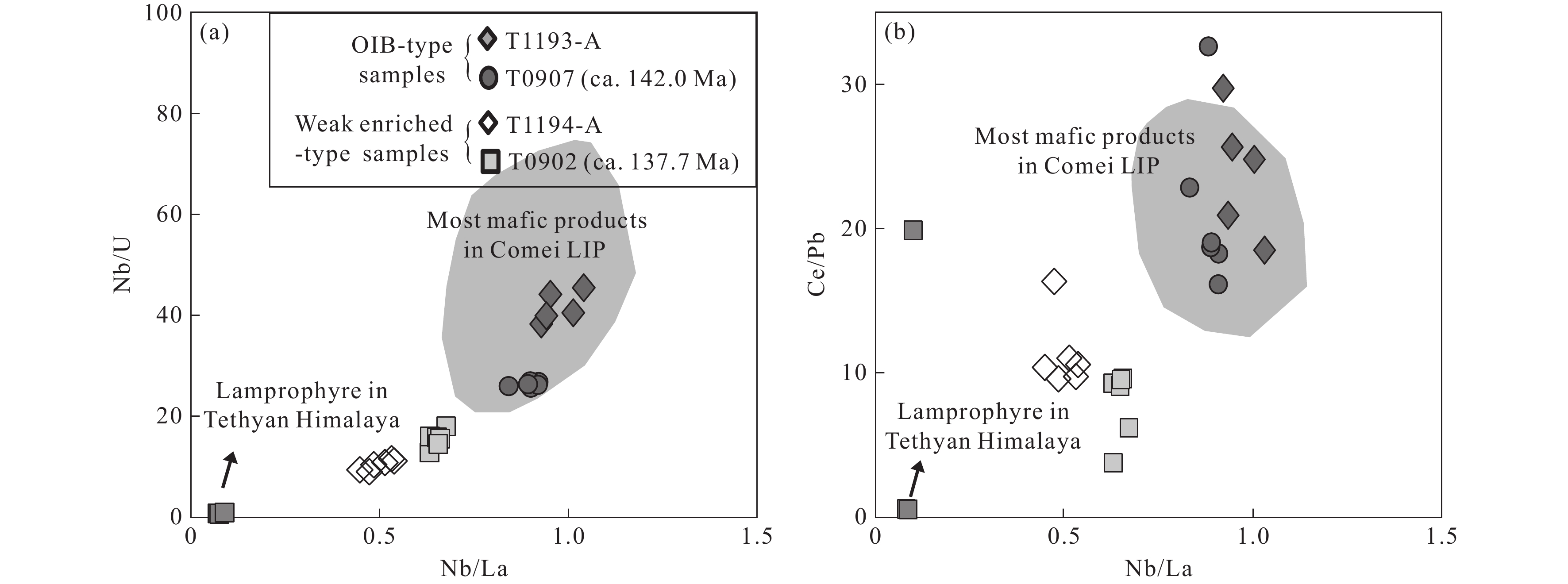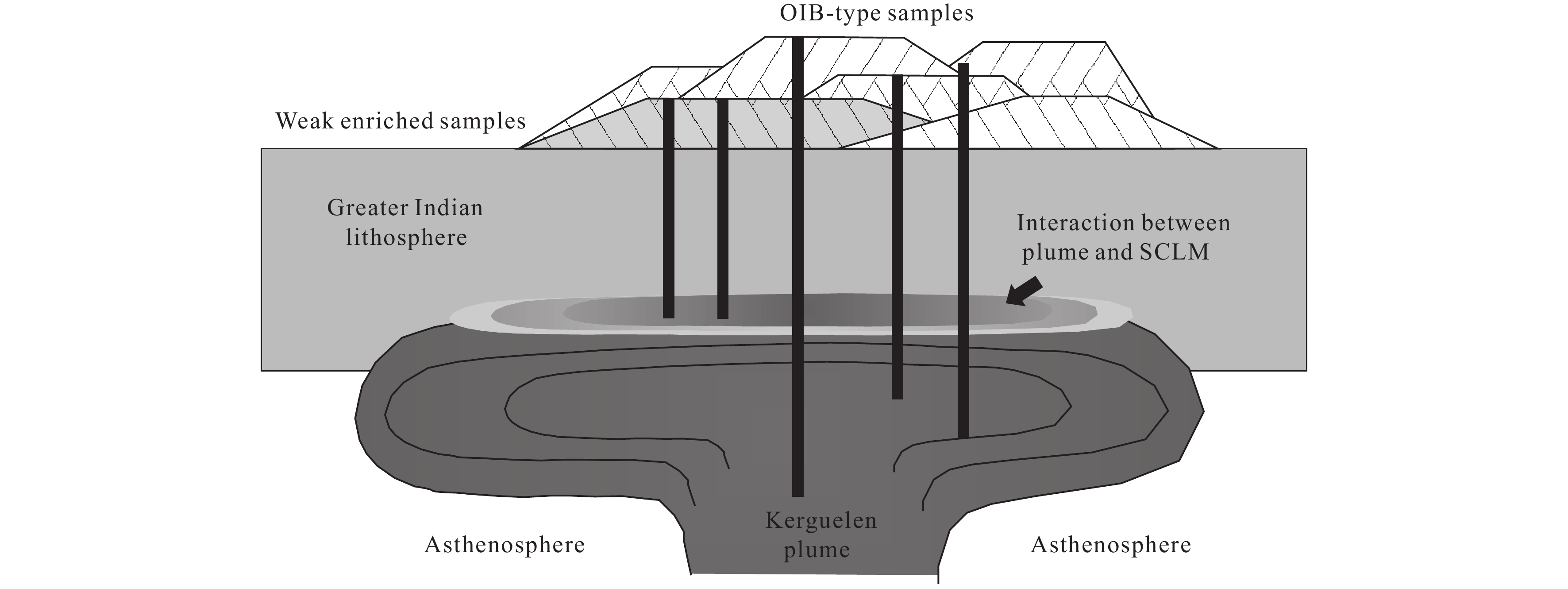| Citation: | Ya-ying Wang, Ling-sen Zeng, Li-e Gao, Li-long Yan, Ling-hao Zhao, Jia-hao Gao, Ying-long Di, Guang-xu Li, Yi-hong Tian, 2024. The plume-lithosphere interaction in the Comei Large Igneous Province: Evidence from two types of mafic dykes in Gyangze, south Tibet, China, China Geology, 7, 80-90. doi: 10.31035/cg2023023 |
The plume-lithosphere interaction in the Comei Large Igneous Province: Evidence from two types of mafic dykes in Gyangze, south Tibet, China
-
Abstract
Two suites of mafic dykes, T1193-A and T1194-A, outcrop in Gyangze area, southeast Tibet. They are in the area of Comei LIP and have indistinguishable field occurrences with two other dykes in Gyangze, T0902 dyke with 137.7±1.3 Ma zircon age and T0907 dyke with 142±1.4 Ma zircon age reported by Wang YY et al. (2016), indicating coeval formation time. Taking all the four diabase dykes into consideration, two different types, OIB-type and weak enriched-type, can be summarized. The “OIB-type” samples, including T1193-A and T0907 dykes, show OIB-like geochemical features and have initial Sr-Nd isotopic values similar with most mafic products in Comei Large Igneous Provinces (LIP), suggesting that they represent melts directly generated from the Kerguelen mantle plume. The “weak enriched-type” samples, including T1194-A and T0902 dykes, have REEs and trace element patterns showing within-plate affinity but have obvious Nb-Ta-Ti negative anomalies. They show uniform lower εNd(t) values (−6‒−2) and higher 87Sr/86Sr(t) values (0.706‒0.709) independent of their MgO variation, indicating one enriched mantle source. Considering their closely spatial and temporal relationship with the widespread Comei LIP magmatic products in Tethyan Himalaya, these “weak enriched-type” samples are consistent with mixing of melts from mantle plume and the above ancient Tethyan Himalaya subcontinental lithospheric mantle (SCLM) in different proportions. These weak enriched mafic rocks in Comei LIP form one special rock group and most likely suggest large scale hot mantle plume-continental lithosphere interaction. This process may lead to strong modification of the Tethyan Himalaya lithosphere in the Early Cretaceous.
-

-
References
Chen FK, Hegner E, Todt W. 2000. Zircon ages, Nd isotopic and chemical compositions of orthogneisses from the Black Forest, Germany - evidence for a Cambrian magmatic arc. International Journal of Earth Sciences, 88(2000), 791–802. doi: 10.1007/S005310050306 Chen FK, Li XH, Wang XL, Li QL, Siebel W. 2007. Zircon age and Nd-Hf isotopic composition of the Yunnan Tethyan belt, southwestern China. International Journal of Earth Sciences, 96(2007), 1179–1194. doi: 10.1007/s00531-006-0146-y Chen SS, Fan WM, Shi RD, Xu JF, Liu YM. 2021. The Tethyan Himalaya Igneous Province: Early Melting Products of the Kerguelen Mantle Plume. Journal of Petrology, 62(1), 1–22. Fitton JG, Saunders AD, Norry MJ, Hardarson BS, Taylor RN. 1997. Thermal and chemical structure of the Iceland plume. Earth and Planetary Science Letters, 153, 197–208. doi: 10.1016/S0012-821X(97)00170-2 Floyd PA, Winchester JA. 1975. Magma type and tectonic setting discrimination using immobile elements. Earth and Planetary Science Letters, 27, 211–218. doi: 10.1016/0012-821x(75)90031-x Gallagher K, Hawkesworth C. 1992. Dehydration melting and the generation of continental flood basalts. Nature, 358, 57–59. doi: 10.1038/358057a0 Hofmann AW, Jochum KP, Seufert M, White WM. 1986. Nb and Pb in oceanic basalts: New constraints on mantle evolution. Earth and Planetary Science Letters, 79, 33–45. doi: 10.1016/0012-821X(86)90038-5 Hu XM, Garzanti E, An W. 2015. Provenance and drainage system of the Early Cretaceous volcanic detritus in the Himalaya as constrained by detrital zircon geochronology. Journal of Palaeogeography, 4(1), 85–98. doi: 10.3724/SP.J.1261.2015.00069 Lassiter JC, Depaolo DJ. 1997. Plume/Lithosphere Interaction in the Generation of Continental and Oceanic Flood Basalts: Chemical and Isotopic Constraint. In: Mahoney, J. J. and Coffin, M. F. (eds. ), Large Igneous Provinces: Continental, Oceanic, and Planetary Flood Volcanism. Geophysical Monograph Series, 100, 335–355. Le Bas MJ, Streckeisen AL. 1991. The IUGS systematics of igneous rocks. Journal of the Geological Society of London, 148, 825–833. doi: 10.1144/gsjgs.148.5.0825 Liu G, Einsele G. 1994. Sedimentary history of the Tethyan basin in the Tibetan Himalayas. Geol Rundsch 83, 32–61. doi: 10.1007/bf00211893. Liu Z, Zhou Q, Lai Y, Qing CS, Li YX, Wu JY, Xia XB. 2015. Petrogenesis of the Early Cretaceous Laguila bimodal intrusive rocks from the Tethyan Himalaya: Implications for the break-up of Eastern Gondwana. Lithos, 236–237, 190–202. doi: 10.1016/j.lithos.2015.09.00. Liu ZC, Wang JG, Liu XC, Liu YD, Lai QZ. 2020. Middle Miocene ultrapotassic magmatism in the Himalaya: A response to mantle unrooting process beneath the orogeny. Terra Nova, 33, 240–251. doi: 10.1111/ter.12507 Lightfoot PC, Hawkesworth CJ, Devey CW, Rogers NW, Van Calsteren WC. 1990. Source and differentiation of Deccan trap lavas: Implications of geochemical and mineral chemical variations. Journal of Petrology, 31(5), 1165–1200. doi: 10.1093/petrology/31.5.1165 Pearce JA. 2008. Geochemical fingerprinting of oceanic basalts with applications to ophiolite classification and the search for Archean oceanic crust. Lithos, 100(1–4), 1448. doi: 10.1016/j.lithos.2007.06.016. Pearce JA. 1982. Trace element characteristics of lavas from destructive plate boundaries. In: Thorpe, R. S. (eds.), Orogenic Andesites. Wiley, Chichester, U. K. , 528–548. Rudnick RL, Gao S. 2003. The composition of the continental crust. In: Rudnick, R. L. (eds.), The Crust, 1–64. Shervais JW. 2022. The petrogenesis of modern and ophiolitic lavas reconsidered: Ti-V and Nb-Th. Geoscience Frontiers, 13, 101319. doi: 10.1016/j.gsf.2021.101319 Shi YR, Hou CY, Anderson JL, Yang TS, Ma YM, Bian WW, Jin JJ. 2018. Zircon SHRIMP U-Pb age of Late Jurassic OIB-type volcanic rocks from the Tethyan Himalaya: Constraints on the initial activity time of the Kerguelen mantle plume. Acta Geochim, 37(3), 441–455. doi: 10.1007/s11631-017-0239-2 Sciunnach D, Garzanti E. 2012. Subsidence history of the Tethys Himalaya. Earth-Science Reviews, 111(2012), 179–198. doi: 10.1016/j.earscirev.2011.11.007 Storey BC. 1995. The role of mantle plumes in continental breakup: Case histories from Gondwanaland. Nature 377(6547), 301–308. doi: 10.1038/377301a0. Sun S, McDonough WF. 1989. Chemical and isotopic systematics of oceanic basalts: Implications for mantle composition and processes, In: Saunders, A. D. and Norry, M. J. (eds. ), Magmatism in the ocean basins. Geological Society Special Publication, 42, 313–345. Wan XQ, Liu WC. 2005. 1∶250000 Gyangze Geological Map. National Geological Archives of China, Beijing Wang YY, Gao LE, Chen FK, Hou KJ, Wang Q, Zhao LH, Gao JH. 2016. Multiple phases of Cretaceous mafic magmatism in the Gyangze-Kangma area, Tethyan Himalaya, southern Tibet. Acta Petrologica Sinica 32, 3572–3596. (in Chinese with English abstract) Wang YY, Zeng LS, Asimow P, Gao Li-E, Antoshechkina P, Guo CL, Hou KJ, Tang SH. 2018. Early Cretaceous high-Ti and low-Ti mafic magmatism in Southeastern Tibet: Insights into magmatic evolution of the Comei Large Igneous Province. Lithos, 296–299, 396–411. doi: 10.1016/j.lithos.2017.11.014. Wang YY, Zeng LS, Zhao LH, Gao Li-E, Gao JH, Hu ZP, Wang HT, Li GX, Di YL, Shen Y, Xu Q. 2020. Baddeleyite and zircon U-Pb ages for of the ultramafic rocks in Chigu Tso area, Southeastern Tibet and their constraints on the timing of Comei Large Igneous Province. China Geology, 2, 262–268. doi: 10.31035/cg2020017 Wang YY, Zeng LS, Hou KJ, Gao Li-E, Wang Q, Zhao LH, Gao JH, Li GX. 2022. Mantle Source Components and Magmatic Evolution for the Comei Large Igneous Province: Evidence from the Early Cretaceous Niangzhong Mafic Magmatism in Tethyan Himalaya. Journal of Earth Science, 33(1), 133–149. doi: 10.1007/s12583-021-1464-5 Wei YS, Liang WX, Shang YM, Zhang BS, Pan WY. 2017. Petrogenesis and tectonic implications of about130 Ma diabase dikes in the western Tethyan Himalaya (western Tibet). Journal of Asian Earth Sciences, 143, 236–248. doi: 10.1016/j.jseaes.2017.04.008 White WM. 2015. Isotopes, DUPAL, LLSVPs, and Anekantavada. Chemical Geology 419, 10–28. doi: org/10.1016/j.chemgeo.2015.09.026 Wu H, Xu ZY, Yan WB, Hao YJ, Liu HY. 2023. Zircon U-Pb ages and geochemical characteristics of diabase in Nie'erco area, central Tibet: Implication for Neo-Tethyan slab breakoff. Geology in China, 50(6), 1804–1816 (in Chinese with English abstract). Xia Y, Zhu DC, Wang Q, Zhao ZD, Liu D, Wang LQ, Mo XX. 2014. Picritic porphyrites and associated basalts from the remnant Comei Large Igneous Province in SE Tibet: Records of mantle-plume activity. Terra Nova, 26(6), 487–494. doi: 10.1111/ter.12124 Xia Y, Wang Q, Zhu DC, Ernst RE, Zhang SQ, Liu D, Zhao ZD. 2020. Intermediate rocks in the Comei large igneous provinces produced by amphibole crystallization of tholeiitic basaltic magma. Lithos, 374–375, 105731. doi: org/10.1016/j.lithos.2020.105731. Xiao L, Xu YG, Mei HJ, Zheng YF, He B, Pirajno F. 2004. Distinct mantle sources of low-Ti and high-Ti basalts from the western Emeishan large igneous province, SW China: Implications for plume–lithosphere interaction. Earth and Planetary Science Letters 228, 525–546. doi: 10.1016/j.jpgl.2004.10.002. Xu YG, He B, Chung SL, Menzies MA, Frey FA. 2004. Geologic, geochemical, and geophysical consequences of plume involvement in the Emeishan flood-basalt province. Geology 32, 917–920. doi: 10.1130/G20602.1 Zhou Q, Liu Z, Lai Y, Wang GC, Liao ZW, Xu Y, Wu JY, Wang SW, Qing CS. 2017. Petrogenesis of mafic and felsic rocks from the Comei large igneous province, South Tibet: Implications for the initial activity of the Kerguelen plume. Geological Society of America Bulletin, 130, 811–824. Zhu DC, Chung SL, Mo XX, Zhao ZD, Niu YL, Song B, Yang YH. 2009. The 132 Ma Comei-Bunbury large igneous province: Remnants identified in present-day southeastern Tibet and southwestern Australia. Geology. 37(7), 583–586. doi: 10.1130/G30001A.1 Zhu DC, Mo XX, Pan GT, Zhao ZD, Dong GC, Shi YR, Liao ZL, Wang LQ, Zhou CY. 2008. Petrogenesis of the earliest Early Cretaceous mafic rocks from the Cona area of the eastern Tethyan Himalaya in south Tibet: Interaction between the incubating Kerguelen plume and the eastern Greater India lithosphere? Lithos, 100 (1–4), 147–173. doi: 10.1016/j.lithos.2007.06.024. -
Access History

-
Figure 1.
a‒Physiographic map of the Indian Ocean and surrounding continents, showing spatial-temporal locations of the Comei LIP and other products created by the Kerguelen plume (after Zhu DC et al., 2008); b‒sketch tectonic map of the east-central Tethyan Himalaya and eastern India showing the present location of the Comei LIP (after Zhu DC et al., 2009); c‒simplified geologic map showing spatial extent and distributions of Comei LIP (after Wang YY et al., 2022) and the location of T1193-A and T1194-A dykes. Other samples, T0902 and T0907, in Gyangze are from Wang YY et al. (2016).
-
Figure 2.
Microphotographs of diabase dyke samples in Gyangze (a) T1193-A and (b) T1194-A.
-
Figure 3.
Classification of diabase dyke samples in Gyangze. a‒IUGS-recommended TAS diagram of Le Bas MJ and Streckeisen AL (1991); b‒an immobile element-based TAS proxy diagram (after Floyd PA and Winchester JA, 1975). T0907 and T0902 samples are from Wang YY et al., (2016).
-
Figure 4.
Variation diagrams of major oxides (%) versus MgO (%) of Gyangze samples in Comei LIP. T0907 and T0902 samples are from Wang YY et al., (2016). All major oxide percentages were recalculated after removing their LOI values.
-
Figure 5.
(a and c) Rare earth element distribution diagrams and (b and d) trace element distribution diagrams. The shaded areas are coeval Gyangze samples from Wang YY et al. (2016). Data of chondrite, primitive mantle, OIB, E-MORB and N-MORB are from Sun SS and McDonough WF (1989).
-
Figure 9.
a–87Sr/86Sr(t) vs. εNd(t) diagram and b–Nb/La vs. εNd(t) diagram of diabase samples in Gyangze.
-
Figure 6.
Tectonic environment discrimination diagram of diabase samples from Gyangze. (a) Zr–Zr/Y diagram (Pearce JA, 1982), WPB: within-plate basalt, MORB: mid-ocean ridge basalt, IAB: island arc basalt and (b) Ti/1000 -V linear plot (Shervais JW, 2022). The shaded areas are “most mafic products in Comei LIP” from OIB-end member samples (Wang YY et al., 2022).
-
Figure 7.
a–Nb/Yb-Th/Yb (after Pearce JA, 2008); b–Zr/Y-Nb/Y (after Fitton JG et al., 1997) diagrams of diabase samples in Gyangze. The shaded areas are “most mafic products in Comei LIP” from OIB-end member samples (after Wang YY et al., 2022).
-
Figure 8.
Plots of (a) Nd/Pb vs. MgO, (b) Nb/U vs. MgO, (c) εNd(t) vs. MgO, and (d) 87Sr/86Sr(t) vs. MgO of Gyangze samples. The data of OIB, N-MORB, and CC (continental crust) are after Sun SS and McDonough WF (1989) and Rudnick RL and Gao S (2003), respectively. Results show that these diagnostic values sensitive to crustal contamination are nearly uniform within T1194-A samples, independent of MgO variation and do not show AFC trend.
-
Figure 10.
a–Nb/U-Nb/La plot; b–Ce/Pb-Nb/La plots of diabase samples in Gyangze. The shaded areas are “most mafic products in Comei LIP” from OIB-end member samples (after Wang YY et al., 2022).
-
Figure 11.
A proposed model of formation of OIB-type and weak enriched rocks in Comei LIP.

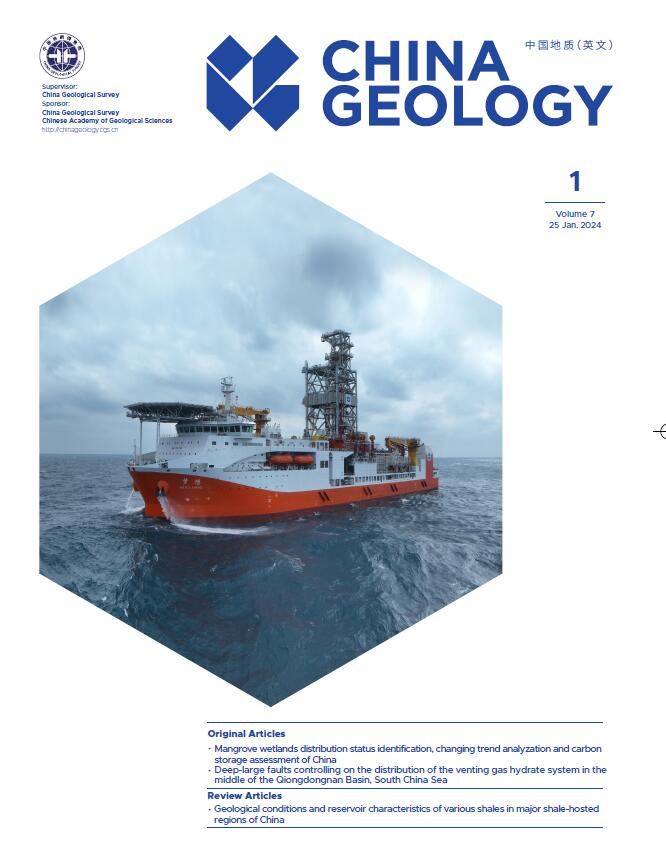

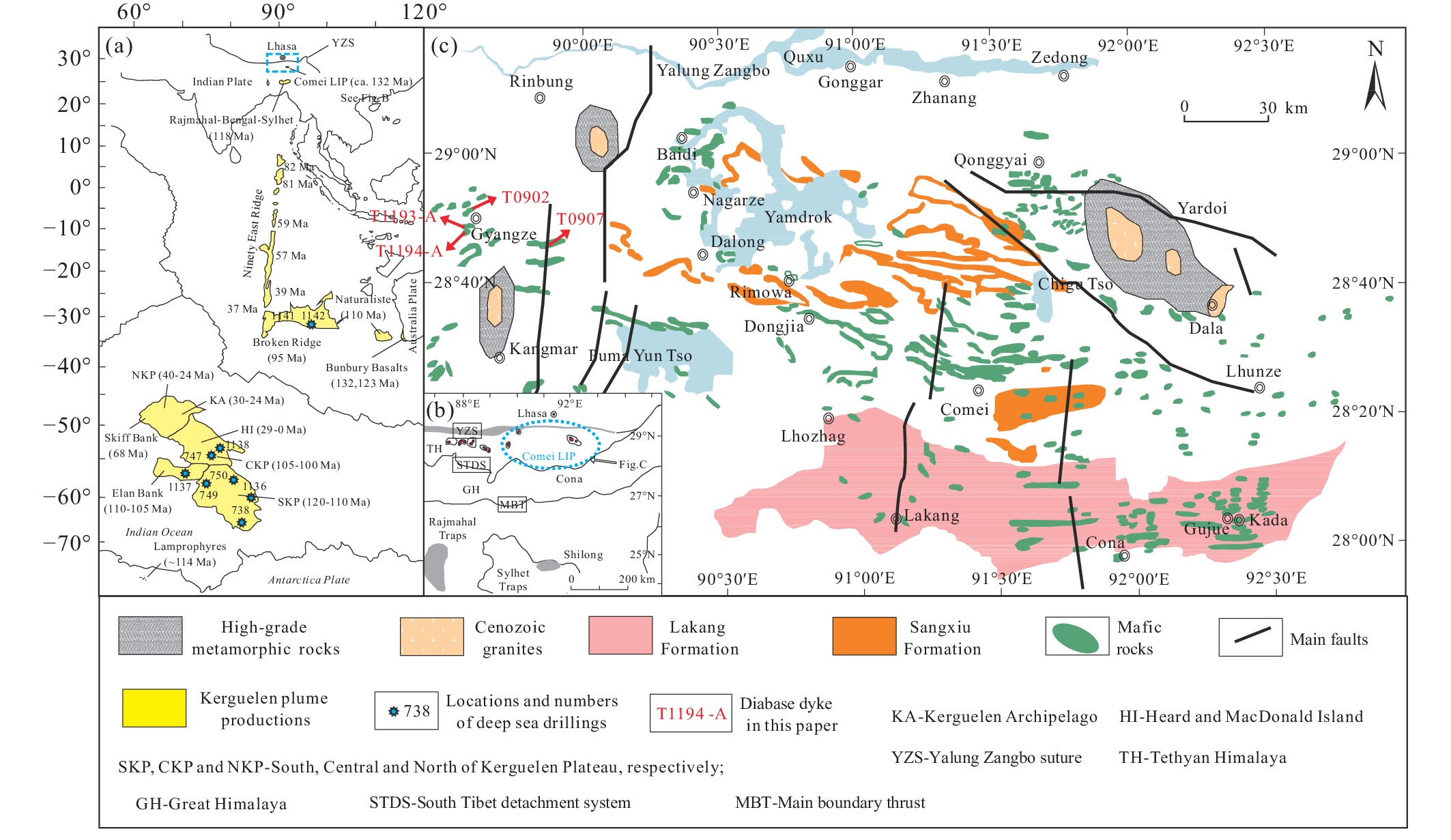

 DownLoad:
DownLoad:


